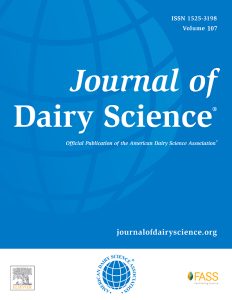Document type: online prepubication of a scientific article in Journal of Dairy Science
Authors: S.B. Doyle, C.L. Wickens, J.M.C. Van Os, E.K. Miller-Cushon
Preview: Approaches for raising calves vary across commercial dairy farms and relate to behavioral opportunities and animal welfare. The objectives of this study were to evaluate how US dairy producers and calf managers perceive 1) welfare implications of varying management practices (including social housing and milk allowance) and behaviors in dairy calves, and 2) aspects of the human-animal relationship in calf rearing and relationships with on-farm management and personal calf handling habits. Survey questions were primarily quantitative (e.g., Likert scales) and addressed how common calf management practices and observed calf behaviors were related to aspects of welfare, including calf health and comfort. We additionally posed questions addressing respondent habits, management protocols, and perceptions related to human-animal interaction. Responses from 93 dairy producers and calf managers were collected via digital surveys. Social housing was viewed as being generally positive for both calf comfort and health, although this view was stronger with respect to calf comfort. Respondents from farms using social housing (56%) had more positive perceptions of social housing, viewed social play as being associated with better calf comfort and health, and considered access to other calves and "freedom to express natural behavior" as being more important for calves, compared with respondents from farms not providing social housing. Providing greater milk allowances (≥7.6 L/d) was viewed as being good for both calf comfort and health, although respondents from farms providing these milk allowances (59%) had more positive perceptions than those who provided lesser allowances. Abnormal oral behaviors were viewed as being associated with both poor calf comfort and health. The welfare importance of various resources which may reduce abnormal oral behaviors (including hay and brushes) was perceived more ambiguously, although respondents from farms providing these resources, compared with those who do not, generally viewed them as more preferred by calves. We observed a positive relationship between how respondents perceived the human-animal bond (i.e., that calves enjoy contact with humans) and stated personal behavior related to calf contact (frequency of contacting calves to scratch or pet them). Respondent demographics were not related to perceptions of the human-animal relationship, but respondents identifying as female described more frequent positive calf interactions. Described aspects of human-animal interactions were not related to implementation of social housing on-farm. Job satisfaction was positively related to perception of the human-animal relationship. Overall, these results suggest that most calf management personnel place a high value on calf welfare, although farms implementing social housing appear to place a greater value on subjective calf well-being and individual perceptions of animal welfare may depend on practical experience.






